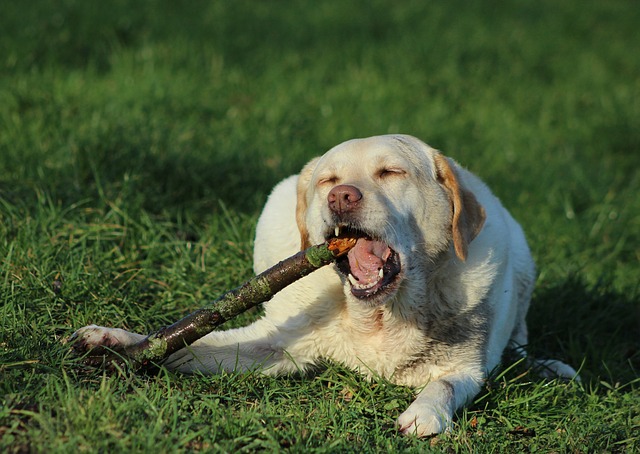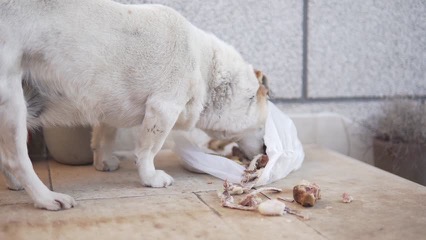Dogs, just like their humans, can quickly and easily become overweight or obese. Losing weight and getting in shape aren’t easy, but your dog will have a healthier, longer life as a result. Helping your cuddly canine friend to lose weight doesn’t have to be hard. However, it does take commitment on your part to help your dog get into shape.
Connect with a verified veterinarian in minutes. Licensed vets are available 24/7 to answer your questions. No need to worry about your furry family member.
Facts About Obesity in Dogs
So, what’s the problem if your pup carries around a few extra pounds and seems healthy otherwise? Let’s take a look at some facts about obesity in dogs.
Based on Research done by the Association for Pet Obesity Prevention (APOP), more than half of the dogs in the U.S. are overweight or obese. This translates into about 41.9 million dogs that weigh too much. What are the health impacts of being overweight or obese for your canine friend?
Health Issues
Your dog’s being overweight or obese makes it more likely your pup could develop serious medical conditions including:
- Certain types of cancer/tumors
- High blood pressure
- Diabetes
- Arthritis
- Heart disease
- Lung disorders
- Immune dysfunction
These are some of the same health issues we face as humans when we’re overweight or obese. Think about that for a minute. Do you or your dog deserve to face such possible fates?
Did you know that if you reduce your pet’s caloric intake, you could be adding 2 or more extra years to his life?
Have you considered the financial costs of obesity? Health conditions, common to overweight and obese dogs, cause more visits to the vet, medications, etc. This raises the financial costs involved with having a pet. One estimate by Nationwide showed that pet obesity in the U.S. ran up to a total of $62 million in veterinary expenses in 2016.
Not only this, but your pet probably doesn’t feel as well or as lively as he used to. Just like overweight people, dogs that are too heavy tend to lay around more. They are lethargic and what some people would call “lazy,” all due to carrying too much weight.
These are some jarring statistics and reason enough to want to put your dog on a diet if he’s a bit chubby or obese. Even a five-pound weight loss can lower the health risks your dog may be facing.
One note of caution: before making any changes to your dog’s diet and activity level, make an appointment with your veterinarian. Your vet will know about your dog’s overall health and will be able to determine the ideal weight for your pet and the best activity level for your dog. In addition, your vet may offer recommendations and suggestions as to the best dogfood and treats to use as your pup loses weight.
How to Get Your Overweight Dog to Lose Weight
There’s a simple weight loss equation to use when your pup needs to lose weight. You’ve probably heard this said about humans, but it also applies to our pets:
Help your dog burn more calories than he eats!
It’s easier said than, done, but taking in fewer calories, while increasing exercise is an excellent first step in helping your dog to lose weight. As your dog loses weight, he’ll feel more energetic and will face lower risks of developing serious medical conditions! Next, we’ll look how to get your overweight dog to lose weight.

Review symptoms, medications & behavior to keep your pets healthy with a Vet Online in just minutes.
Ask a Vet Live NowWeight Loss Tools for You and Your Dog
You and your canine pal will need some tools to help your dog lose weight. These tools are simple and inexpensive, but can go a long way to keep you and your pet on the weight loss track.
Tools you’ll need:
- Scale: to weigh your dog and track his weight. You can either use your bathroom scale to weight your dog, or you may need to visit your vet and use their scale if you have a large dog. For small to medium dogs, first weigh yourself and note your weight. Then pick up your dog and hold him while you’re on the scale. Note that number and then subtract your own weight from this number. This will give you your dog’s current weight.
- Dog weight loss calculator: helps you to determine how much weight your dog needs to lose and how many calories are necessary for your dog each day. You can find a free dog weight loss calculator online:
- Pet Nutrition Alliance: http://www.petnutritionalliance.org/dog.php
The other tools you may need is a notebook to record your dog’s weight loss progress, some good sneakers and a leash!
How to Help a Dog Lose Weight Fast
Is there a fast way to help your dog lose weight? We’ve taken a look at the tools you can use to help your dog lose weight. Now we’ll take a look at some methods you can use to help your pet slim down. Here are some ways to help your dog lose weight fast:
1). Limit calories: this is one of the easiest and fastest ways to lose weight. However, you’ll need to make sure your dog is getting enough calories to meet his daily activity and bodily function requirements.
2). Measure food: use a proper measuring cup to measure your dog’s food and to avoid over-feeding. This make it easy to track how much your dog’s eating, while ensuring he’s getting the right serving size for each meal.
3). Don’t leave food available: it’s best to avoid leaving food available all day, as most dogs don’t self-regulate when it comes to food. But be sure your pup has access to fresh water all day long!
4). Feed more often: try giving your dog smaller meals throughout the day. Your dog may feel more satisfied and full most of the day. This method is better than feeding your dog one or two regular meals a day, as his blood sugar will be steadier, and he’ll use up any extra calories, rather than storing them as fat.
5). Avoid table scraps: table scraps and our human food are highly tempting to dogs. Plus, we like to pamper our pooches with small scraps now and then. However, table scraps may be making your dog overweight or obese. Don’t give your dog table scraps, and you’ll see him start to lose weight!
Here, we’ve taken a look at how to help a dog lose weight fast. Next, we’ll learn about raw food diets for weight loss in dogs.
How to Put Dog on Raw Diet
While a raw food diet is still controversial, many hold to the diet to help their dogs lose weight. What is the raw food diet? It’s a special diet that allows dogs to eat the foods they’d eat in nature. Raw foods include raw meat (beef, pork, poultry), vegetables and fruits, and even includes bones.
Some of the raw food diet’s controversy stems from the fact that raw meat may contain harmful bacteria.
Raw food diet may not provide all the nutrition and calories your dog needs just to stay healthy
It’s easy to feed your dog raw meat, but you also need to make sure your pup is getting the right amount of calcium and phosphorous, which are important to maintain healthy bones and teeth. Too much liver in a raw food diet can cause serious health complications such as vitamin A toxicity—a form of liver disease. So, getting your dog’s nutrition right is key on how to put dog on raw diet. (1231)
Weight Loss Dog Food Recipes
Another way you can help your dog lose weight is by creating homecooked meals for him! Your dog will be in seventh heaven with homemade dog food! A word of caution—just like with the raw food diet, you’ll need to make sure your pup gets his daily requirement of calories and nutrition. It’s necessary to ensure your dog’s food is nutritionally complete and balanced over time.
Variety is the key to ensuring your homemade dog food is healthy and meeting your dog’s health requirements. A variety of foods including red meat, poultry, fish, liver (in small amounts—not daily), eggs, dairy, vegetables and fruits with occasional grains and legumes. About 50% of your dog’s food should include animal protein. In addition, it’s a good idea to steam or puree vegetables for your dog. Dog’s don’t easily digest plant-based foods.
Weight loss dog food recipes abound online—just make sure to only use trusted, authority sites to be sure that your food is healthy for your pet.
To start your pet on a homemade weight loss diet, it will be necessary to go slowly to avoid tummy and digestive problems. Any major switch in diet can cause these issues, but a slow transition from your dog’s regular food to homemade dog food should be OK, as long as your dog’s healthy. You can begin by adding fresh home cooked food to your dog’s current dog food. Start with ¾ of your dog’s normal food, then add ¼ home cooked food and mix. Over several weeks, begin changing the ratio of normal food with home cooked food—decreasing your dog’s commercial food and adding fresh food.
Remember this will take some time, be patient with you pal as he transitions to his new diet
Note of caution: homemade food diets are generally not recommended for puppies. This is because it’s difficult to make sure your homemade puppy food contains all the nutrients and calories that puppies need to grow up strong and healthy. Check with your veterinarian before putting your puppy or adult dog on a homemade diet.
Summing It Up
As you can see, it’s not too hard to start your cuddly canine friend on a weight loss diet. You need to take your pup to the vet for a checkup before making any changes to his diet. Your veterinarian will be the best source of information and guidance as to the best way for your dog to lose weight and what he should/should not be eating. You only need some simple tools to get started, then follow the easy weight loss equation, and stay committed to helping your fur baby lose the weight and get in shape, for a healthier and longer life.
Connect with a verified veterinarian in minutes. Licensed vets are available 24/7 to answer your questions. No need to worry about your furry family member.

Kyoko
Kyoko is from a family of 3 and moved to New York with her parents and siblings when she was 13. Kyoko is fond of spending a great amount of time with pets, specifically her beagle Luna and cat Missy. Her boyfriend often complains that she spends too much time giving attention to their animals. Kyoko has written dozens of articles concerning pets and is aiming at owning a pet shop one day!
Review symptoms, medications & behavior to keep your pets healthy with a Vet Online in just minutes.
Ask a Vet Live Now



